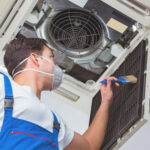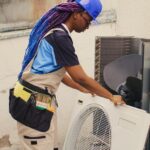
Key Factors to Consider When Installing a New HVAC System
Key Factors to Consider When Installing a New HVAC System
Installing a new HVAC system is a significant investment for any homeowner or business owner. It’s a decision that requires careful consideration of various factors to ensure optimal performance, energy efficiency, and long-term cost savings. From selecting the right type of system to assessing your building’s unique heating and cooling needs, there are several key factors to keep in mind. In this blog post, we’ll explore the essential considerations you should weigh when installing a new HVAC system to make an informed decision that meets your requirements.
Understanding HVAC System Installation
Installing an HVAC system involves more than simply setting up equipment. It necessitates a deep comprehension of the building’s layout, insulation, and airflow dynamics. Professionals must assess various factors such as space size, local climate conditions, and energy efficiency objectives to recommend the most appropriate system. Whether it’s a central air conditioning unit, a heat pump, or a ductless mini-split, each system presents unique installation requirements and considerations.
Proper installation is paramount to achieving optimal performance, energy efficiency, and indoor comfort for occupants. It’s the foundation upon which the system’s effectiveness and longevity are built, ensuring a comfortable and sustainable indoor environment.
Importance of Thoughtful Consideration
The decision to install a new HVAC system is significant and warrants careful consideration. Rushing into such a decision without thorough planning can lead to suboptimal outcomes and potential issues down the line. Homeowners and business owners alike must weigh various factors, including budget constraints, energy efficiency goals, and building requirements.
Thoughtful consideration involves assessing existing infrastructure, evaluating long-term cost savings, and researching different system options. By taking the time to consider all relevant factors, individuals can make informed decisions that align with their needs and priorities, ultimately maximizing the benefits of their HVAC investment.
Types of HVAC Systems
When considering HVAC options, it’s essential to understand the different types available. Traditional central heating and air conditioning systems use ductwork to distribute conditioned air throughout the building. Heat pumps offer both heating and cooling capabilities by transferring heat between the indoors and outdoors. Ductless mini-split systems are ideal for spaces without ductwork, providing individualized temperature control for each room.
Geothermal heat pumps utilize the earth’s constant temperature for efficient heating and cooling. Each type of system has its advantages and considerations, making it crucial to select the one that best fits the building’s layout, energy efficiency goals, and budget.
Assessing Heating and Cooling Needs
Before installing a new HVAC system, it’s crucial to assess the specific heating and cooling requirements of the building. Factors such as square footage, insulation quality, window placement, and local climate conditions all play a role in determining the system’s size and capacity needed.
A professional assessment can help determine the appropriate heating and cooling loads, ensuring that the system is neither underpowered nor oversized. By accurately assessing these needs, homeowners and business owners can select an HVAC system that provides optimal comfort and efficiency while minimizing energy waste and operating costs.
Energy Efficiency Standards
One of the critical considerations when installing a new HVAC system is its energy efficiency. Modern HVAC systems are subject to various energy efficiency standards and ratings, such as SEER (Seasonal Energy Efficiency Ratio) for air conditioners and AFUE (Annual Fuel Utilization Efficiency) for furnaces. Higher SEER and AFUE ratings indicate greater efficiency, translating to lower energy consumption and operating costs over time.
Additionally, certifications like ENERGY STAR signify compliance with rigorous energy efficiency criteria set by the Environmental Protection Agency (EPA). Prioritizing energy-efficient HVAC equipment not only reduces utility bills but also minimizes environmental impact by conserving energy resources.
Budgeting for Installation Costs
Budgeting for HVAC installation involves more than just the upfront equipment costs. Homeowners and business owners must consider various expenses associated with the installation process. These may include labor costs for professional installation, permits and inspection fees, ductwork modifications or installations, and any additional accessories or upgrades required.
It’s essential to obtain multiple quotes from reputable HVAC contractors and factor in potential long-term savings from energy-efficient equipment. While upfront costs are significant, investing in a quality HVAC system and professional installation ensures reliable performance, optimal comfort, and potential savings on future repairs and energy bills.
Hiring Qualified Professionals
Selecting the right HVAC contractor is crucial for a successful installation. Qualified professionals possess the necessary expertise, certifications, and experience to assess your needs accurately and recommend suitable solutions. Look for contractors licensed by relevant authorities and certified by manufacturers to install specific HVAC systems. Additionally, consider their reputation, customer reviews, and industry affiliations.
A reputable contractor will provide detailed estimates, explain the installation process, and offer warranties for their workmanship. By hiring qualified professionals, you ensure the installation is done correctly, maximizing system efficiency, performance, and longevity while minimizing the risk of costly errors or safety hazards.
Proper Sizing for Efficiency
One common mistake in HVAC installation is improper sizing of equipment. Oversized systems may short cycle, resulting in inefficient operation, increased energy consumption, and premature wear and tear. Undersized units, on the other hand, struggle to meet heating and cooling demands, leading to discomfort and higher utility bills. Proper sizing involves calculating the heating and cooling loads of the building based on factors such as square footage, insulation, windows, and occupancy.
HVAC professionals use Manual J calculations to determine the right size equipment for optimal efficiency and comfort. By ensuring proper sizing, you avoid wasted energy, enhance system performance, and prolong the lifespan of your HVAC system.
Evaluating Ductwork
Before installing a new HVAC system, it’s essential to assess the condition and design of the existing ductwork. Leaks, gaps, and inadequate insulation can significantly reduce system efficiency and compromise indoor air quality. A professional ductwork inspection identifies any issues and recommends necessary repairs or upgrades. Properly sealed and insulated ducts ensure that conditioned air reaches its destination efficiently, minimizing energy waste and improving comfort levels throughout the building.
Additionally, ductwork modifications may be necessary to accommodate the airflow requirements of the new HVAC system. By evaluating and optimizing ductwork, you enhance the performance and longevity of your HVAC investment while maximizing energy savings.
Choosing the Right Equipment
Selecting the appropriate HVAC equipment is a critical decision that impacts the comfort, energy efficiency, and overall performance of your system. Consider factors such as the size and layout of the space, climate conditions, energy efficiency ratings, and budget constraints when choosing between different models and brands. Consult with HVAC professionals to determine the most suitable equipment type, whether it’s a central air conditioning unit, heat pump, furnace, or ductless mini-split system.
Pay attention to energy efficiency ratings like SEER, EER, and HSPF for cooling and heating equipment, as higher ratings indicate greater efficiency and potential cost savings over time. Additionally, consider features such as variable-speed motors, zoning capabilities, and smart thermostat compatibility for enhanced comfort and control. By choosing the right equipment, you ensure optimal performance, comfort, and energy efficiency for years to come.
Considering Environmental Impact
In today’s world, environmental responsibility is a crucial consideration when installing a new HVAC system. Opting for energy-efficient equipment, such as those with ENERGY STAR certification, can significantly reduce greenhouse gas emissions and minimize your carbon footprint. Additionally, consider environmentally friendly refrigerants that have lower global warming potential (GWP) and ozone depletion potential (ODP) compared to traditional refrigerants like R-22.
Moreover, explore renewable energy options such as geothermal heat pumps or solar-assisted HVAC systems to further reduce reliance on fossil fuels. By prioritizing the environmental impact of your HVAC choices, you contribute to sustainability efforts while enjoying long-term energy savings.
Future Maintenance Considerations
While installing a new HVAC system is an important investment, ongoing maintenance is essential to ensure its continued performance and longevity. Develop a maintenance plan that includes regular inspections, filter replacements, and cleaning to keep the system running efficiently. Consider signing up for a maintenance contract with a reputable HVAC service provider to receive scheduled tune-ups and priority service in case of emergencies.
Addressing minor issues promptly can prevent costly repairs and extend the lifespan of your equipment. Moreover, stay informed about technological advancements and industry best practices to implement upgrades or optimizations that enhance efficiency and comfort over time.
Maximizing Long-Term Benefits
When installing a new HVAC system, it’s crucial to focus on maximizing long-term benefits beyond initial cost savings. Invest in high-quality equipment with proven reliability and energy efficiency to minimize operating costs and reduce the risk of premature failures. Additionally, prioritize proper installation by hiring qualified professionals who follow industry standards and best practices. Take advantage of available incentives, rebates, and financing options to make your investment more affordable.
Moreover, educate yourself about energy-saving behaviors and utilize programmable thermostats or smart HVAC controls to optimize comfort while conserving energy. By taking a proactive approach to HVAC installation and maintenance, you can enjoy enhanced comfort, lower energy bills, and greater peace of mind for years to come.
The installation of a new HVAC system is a pivotal decision for any homeowner or business owner. By carefully considering key factors such as building requirements, energy efficiency goals, and professional installation, you can ensure optimal comfort and long-term savings. At Cool Factory, Inc in Sterling, VA, we’re dedicated to providing top-notch HVAC solutions tailored to your specific needs.
Trust our experienced team to guide you through every step of the installation process. For expert advice and quality service, contact us today at (703) 713-5113. Let’s work together to create a comfortable and efficient indoor environment for you to enjoy.






